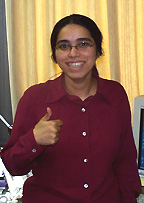
| T H E N I H C A T A L Y S T | S E P T E M B E R – O C T O B E R 2001 |
|
|
|
THUMBS UP:DEALING WITH REPETITIVE STRESS INJURIES |
|
 |
|
Fatima
Husain
|
It started simply enough last fall with a twinge in my right thumb. A week later, the twinge had escalated to a painful throb. I switched from the trackball (which I had just started using) back to my trusted mouse. Despite the intervening winter holidays, the pain persisted over the next two months. Simple tasks like zipping my jacket, brushing my teeth, or twisting doorknobs became fraught with sharp pains.
Finally, at the recommendation of my supervisor, I visited the Occupational Medical Service (OMS) on the 6th floor of Building 10. I was diagnosed with tendonitis (inflammation of the tendons) of my right thumb, one of the many repetitive stress injuries (RSI) you may encounter in the workplace.
RSIs are disorders of the musculoskeletal system caused by the cumulative effects of tiny amounts of damage. They occur over a period of time when muscles or joints are stressed, tendons are inflamed, nerves are pinched, and the flow of blood is restricted.
The most famous of the RSIs is carpal tunnel syndrome, caused by a pinched nerve at the wrist. Early intervention in RSI is important, partly to avoid unnecessary pain and partly to prevent more permanent damage.
At NIH, we have a number of resources to combat RSI. The first line of defense is online information: a guide to ergonomics, which details RSI causes and prevention strategies, and another guide that includes a chart to help evaluate your symptoms and a series of simple illustrated exercises to combat RSI. You can also visit another website to download timekeeper-type shareware software that reminds you to take breaks at your desktop.
If you’d like an evaluation by medical personnel, you can make an appointment with OMS at 6-4411. After a nurse has determined that your symptoms appear to be work-related, you will be evaluated by a physician or a physician assistant. Generally the treatment is to reduce inflammation, rest the injured area, strengthen the muscles around the area, and take suggested steps to prevent such injuries in the future. An OMS physical therapist is also available should such continuing service be needed.
When warranted, OMS will recommend that you continue treatment with a specialist outside NIH. OMS may also recommend an ergonomic evaluation of your workspace by an Occupational Safety and Health Branch specialist.
In my own case, after five visits with the OMS physical therapist (about two months after my original diagnosis), the inflammation in my right thumb had gone down significantly and most of the pain had vanished.
Today, months later. I
sense no inflammation or pain in my thumb. To prevent future inflammation, I
often use my left hand for gross motor skills like manipulating the mouse. I
also practice simple exercises to strengthen the muscles of my right hand and
take frequent breaks at work. ![]()
Acknowledgments
M’Lou Stevens, PA-C, OMS
Terry Black, Physical Therapist, OMS